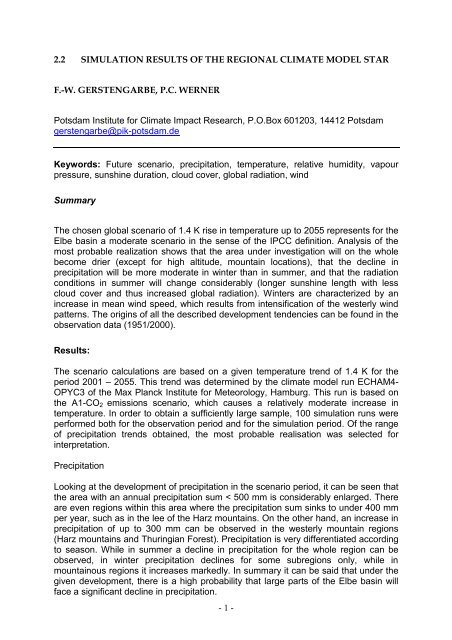2.2 SIMULATION RESULTS OF THE REGIONAL CLIMATE MODEL ...
2.2 SIMULATION RESULTS OF THE REGIONAL CLIMATE MODEL ...
2.2 SIMULATION RESULTS OF THE REGIONAL CLIMATE MODEL ...
You also want an ePaper? Increase the reach of your titles
YUMPU automatically turns print PDFs into web optimized ePapers that Google loves.
<strong>2.2</strong> <strong>SIMULATION</strong> <strong>RESULTS</strong> <strong>OF</strong> <strong>THE</strong> <strong>REGIONAL</strong> <strong>CLIMATE</strong> <strong>MODEL</strong> STAR<br />
F.-W. GERSTENGARBE, P.C. WERNER<br />
Potsdam Institute for Climate Impact Research, P.O.Box 601203, 14412 Potsdam<br />
gerstengarbe@pik-potsdam.de<br />
Keywords: Future scenario, precipitation, temperature, relative humidity, vapour<br />
pressure, sunshine duration, cloud cover, global radiation, wind<br />
Summary<br />
The chosen global scenario of 1.4 K rise in temperature up to 2055 represents for the<br />
Elbe basin a moderate scenario in the sense of the IPCC definition. Analysis of the<br />
most probable realization shows that the area under investigation will on the whole<br />
become drier (except for high altitude, mountain locations), that the decline in<br />
precipitation will be more moderate in winter than in summer, and that the radiation<br />
conditions in summer will change considerably (longer sunshine length with less<br />
cloud cover and thus increased global radiation). Winters are characterized by an<br />
increase in mean wind speed, which results from intensification of the westerly wind<br />
patterns. The origins of all the described development tendencies can be found in the<br />
observation data (1951/2000).<br />
Results:<br />
The scenario calculations are based on a given temperature trend of 1.4 K for the<br />
period 2001 – 2055. This trend was determined by the climate model run ECHAM4-<br />
OPYC3 of the Max Planck Institute for Meteorology, Hamburg. This run is based on<br />
the A1-CO 2 emissions scenario, which causes a relatively moderate increase in<br />
temperature. In order to obtain a sufficiently large sample, 100 simulation runs were<br />
performed both for the observation period and for the simulation period. Of the range<br />
of precipitation trends obtained, the most probable realisation was selected for<br />
interpretation.<br />
Precipitation<br />
Looking at the development of precipitation in the scenario period, it can be seen that<br />
the area with an annual precipitation sum < 500 mm is considerably enlarged. There<br />
are even regions within this area where the precipitation sum sinks to under 400 mm<br />
per year, such as in the lee of the Harz mountains. On the other hand, an increase in<br />
precipitation of up to 300 mm can be observed in the westerly mountain regions<br />
(Harz mountains and Thuringian Forest). Precipitation is very differentiated according<br />
to season. While in summer a decline in precipitation for the whole region can be<br />
observed, in winter precipitation declines for some subregions only, while in<br />
mountainous regions it increases markedly. In summary it can be said that under the<br />
given development, there is a high probability that large parts of the Elbe basin will<br />
face a significant decline in precipitation.<br />
- 1 -
Temperature<br />
Since the changes for temperature are predetermined by the underlying model<br />
philosophy, temperature need not be discussed here. We mention only that the<br />
spatial structures of the temperature distribution are unchanged in the simulation.<br />
Relative humidity<br />
The spatial structures of the annual mean of relative humidity shows approximately<br />
the same structure for both investigation periods, although at a different level. The<br />
mean level for the period 2046/55 is 3% lower than for the reference period<br />
1951/2000. But the relative humidity in the mountains and the northern part of the<br />
investigation area is greater than for the other parts of the Elbe basin. In the drier<br />
areas, particularly, there is a tendency that this situation is further intensified. The<br />
spatial structures are retained both in summer and in winter. However, a much<br />
greater decrease can be seen in summer than in winter.<br />
Water vapour pressure<br />
The spatial structures of the annual mean values of vapour pressure mirror the<br />
geographic and orthographic features of the investigation area both for the reference<br />
and the scenario periods (higher values in the NW, lower values in the mountains).<br />
The vapour pressure increases slightly for the whole investigation area in the<br />
scenario period, in summer more than in winter.<br />
Sunshine duration<br />
A significant increase in sunshine duration can be seen for the summer in the<br />
scenario period. There are regions where it increases by 1.5 hours per day. In winter<br />
there are negligible changes only.<br />
Cloud cover<br />
Similarly to sunshine duration, the amount of cloud cover is spatially only weakly.<br />
Inversely to sunshine duration, the annual mean cloud amount decreases for the<br />
scenario period, with a considerably stronger decrease in summer than in winter, but<br />
with some regions even showing a slight increase.<br />
Global radiation<br />
For global radiation, the scenario period shows greater spatial differentiation than the<br />
reference period. Overall global radiation increases, with the trend being much<br />
stronger in summer than in winter.<br />
Wind velocity<br />
Wind velocity declines in summer for almost the whole investigation area. In winter,<br />
however, an increase can be observed.<br />
- 2 -
















